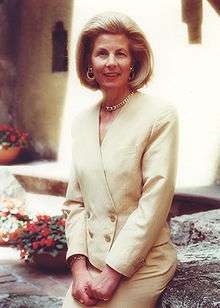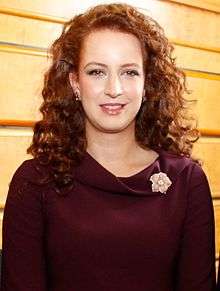Princess consort
Princess consort is an official title or an informal designation that is normally accorded to the wife of a sovereign prince. The title may be used for the wife of a king if the more usual designation of queen consort is not used.
More informally, it may even be used to describe the family position of any woman who marries royalty non-morganatically, if the rank she derives from that marriage is at least that of a princess (e.g., Grace Kelly was Princess Consort during marriage, whereas Liliane Baels and Countess Juliana von Hauke are not usually so described).
The "consort" part is often dropped when speaking or writing of a princess consort, and the term is only capitalized when the title is borne officially. Currently, there are two sovereign princesses consort in Europe: Marie, Princess of Liechtenstein and Charlene, Princess of Monaco. Their husbands, both sovereign monarchs of their respective realms, are styled "Prince" and not "King".
United Kingdom
Clarence House announced that when Camilla, Duchess of Cornwall's husband Charles, Prince of Wales accedes to the throne of the United Kingdom, she will not use the legal style of queen consort. She intends to use the style of "princess consort", even though her husband would not be a sovereign prince but a sovereign king.[1][2] Such a title has no historical precedent; under English common law, wives of kings automatically become queens. The Guardian reported in 2017 that experts expect that "the fiction will end when Elizabeth II dies" and Camilla will be queen.[3] Clarence House in 2018 removed the statement from its website, suggesting that Camilla will be styled as queen consort upon her husband's accession.[4] This was the case with all other women married to British kings regnant, who became queens consort—with the exception of queens co-reigning with their husbands.[note 1]
The current consort of Elizabeth II, Prince Philip, Duke of Edinburgh, is styled as prince rather than king consort. Prince Albert, consort of Queen Victoria, was accorded the style of Royal Highness upon their marriage in 1840, but was not accorded any formal title until 1857 (four years before his death) when he was created prince consort.
Morocco
The consort of King Mohammed VI of Morocco, Princess Lalla Salma, is styled as HRH the Princess Consort, the first Moroccan royal consort to receive any title.
Current princesses consort
| Princess consort | Country | Date of succession | Spouse |
|---|---|---|---|
Marie  | 13 November 1989 | Hans-Adam II, Prince of Liechtenstein | |
Lalla Salma  | 21 March 2002 | Mohammed VI, King of Morocco | |
Charlene | 1 July 2011 | Albert II, Prince of Monaco | |
Notes and references
Notes
- Upon Queen Mary I’s marriage to Philip II of Spain, an Act of Parliament made him joint sovereign for its duration. Mary II was crowned sovereign jointly with William III & II.
References
- "The Prince of Wales". The British Monarchy. Archived from the original on 7 March 2015. Retrieved 21 April 2016.
After the wedding, Mrs Parker Bowles became known as HRH The Duchess of Cornwall. When The Prince of Wales accedes to the throne, she will be known as HRH The Princess Consort.
- "Clarence House press release". Clarence House. 10 February 2005. Archived from the original on 24 June 2014. Retrieved 6 April 2018.
- Knight, Sam (2016-03-17). "Operation London Bridge: the secret plan for the days after the Queen's death". The Guardian. Retrieved 2016-03-17.
- Furness, Hannah (10 March 2018). "Could Camilla become Queen after all? Clarence House quietly removes statement about Duchess of Cornwall's future role". The Telegraph. Retrieved 11 March 2018.
.svg.png)